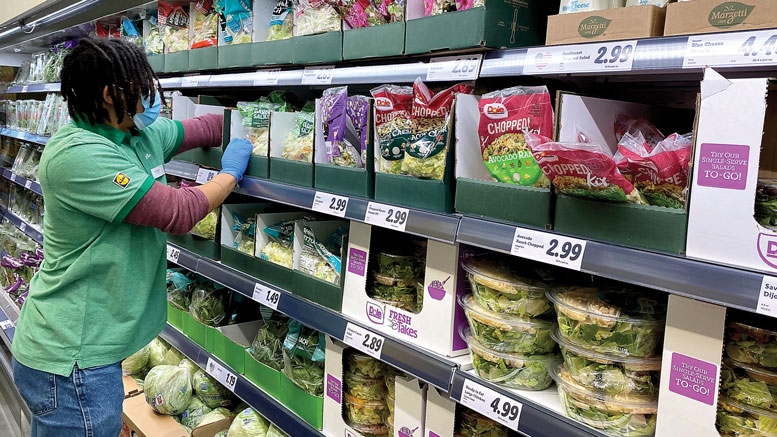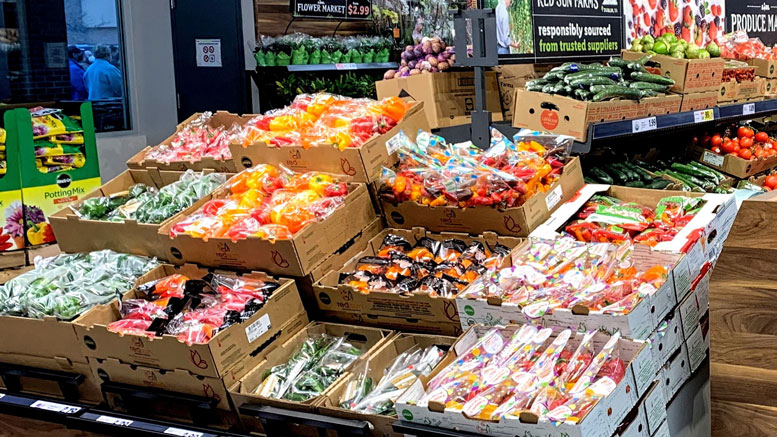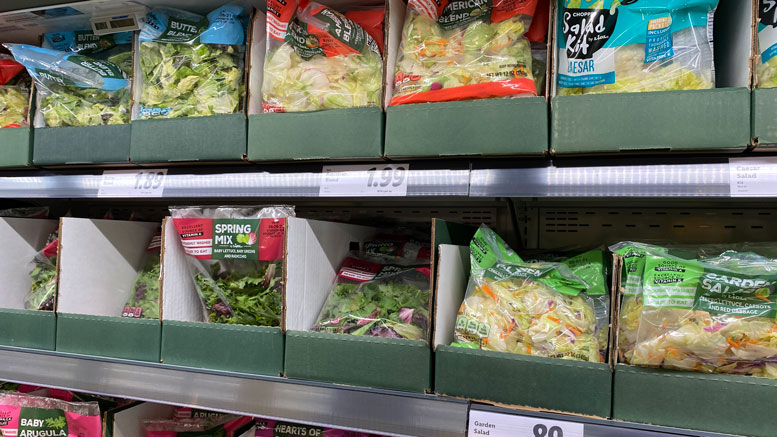Safety and Sustainability Wrapped Up in One Package
September 13, 2021 | 10 min to read
The article discusses how packaging plays a crucial role in increasing consumer comfort and driving sales in the produce market. With a projected demand increase for corrugated boxes, retailers like Aldi and Lidl are leveraging retail-ready packaging to reduce labor costs and enhance consumer engagement through digital innovations like QR codes. The COVID-19 pandemic has heightened consumer concerns over food safety, making packaged produce more attractive, while sustainability remains a pressing issue for both producers and consumers.

Packaging can make consumers more comfortable buying produce — and may even persuade them to buy more.
Originally printed in the August 2021 issue of Produce Business.
Of all the what-ifs emerging from the COVID-19 pandemic, the future direction of produce packaging is among the hardest to nail down, except that more demand is inevitable.
Whether primary or secondary, a number of market conditions have made packaging a more important factor in produce departments across the United States.

Cleveland, OH-based market research firm The Freedonia Group projects demand for corrugated boxes used to package fresh produce will increase 3.3% per year to $2.4 billion in 2024. Greater use of value-added boxes, such as those with retail-ready features that reduce labor costs, will be a major factor in segment growth.
Despite competition from reusable plastic containers, retail-ready corrugated boxes will continue gaining in fresh produce applications due to low cost and ease of printing with high-quality graphics.
“Produce marketers are increasingly turning to packaging to tell their product story and engage consumers in ways similar to what the processed food industry has done for decades,” says Michael Hayford, GP Corrugated general sales manager at Georgia-Pacific, Atlanta, GA. “Whether it is QR codes that link to recipes or more complex, augmented reality implementations that connect to promotional campaigns, produce packaging has become a highly valuable marketing channel.
“Digitally printed packaging is taking that even further by giving marketers the ability to easily create seasonal and regionally specific packaging.”
With digital pre-print, such as GP’s Hummingbird digital print solutions, a grower can create regional or seasonal designs without having to order or inventory large quantities of each design. Digital printing also allows a local farm to tell their story by adding a QR code that gives the consumer the ability to further explore the product or its journey to the store.
“Our customers have seen value in being able to differentiate themselves and draw consumers to their product,” Hayford says. “One of our customers has been able to compete with larger companies by using digital print for bins to capture consumer attention with eye-catching designs.”
In addition to graphics, packaging presentation gives consumers confidence in the items they are buying. Kurt Zuhkle Jr., of Kurt Zuhlke & Associates, Bangor, PA, says the packaging industry can provide produce in clear clamshells using principles developed for selling fruits and vegetables in bulk.
“You’re seeing more compartmentalized packaging with one type of item in three different colors, say of cherry tomatoes, or with sections of blueberries, strawberries and red raspberries for people to take home and put on their cereal as a convenience,” he says.
RETAIL TRENDS
The growth of low-cost grocery chains such as Aldi and Lidl, where retail-ready boxes help lower labor costs, is also driving the produce packaging evolution.
Aldi expects to become the third largest supermarket chain in the United States, behind Kroger and Walmart, with 2,500 stores by the end of 2022. Although its once warehouse-style merchandising has shifted over time to more closely resemble that of supermarkets, Aldi still incorporates labor-saving practices. For example, produce gets merchandised in a variety of retail-ready packaging, including bags, plastic tubs, cups, bowls and trays.
Lidl, a discount grocer based in Germany, has generally positioned itself even closer to traditional grocery outlets in its worldwide expansion, which includes the U.S., a market it entered in 2017 and where it now operates more than 130 stores. According to The Freedonia Group, Lidl’s use of Corrugated Common Footprint containers, available in a variety of sizes, improves effectiveness, and boosts supply chain logistics by creating uniformity between the boxes used to ship fruits and vegetables.
During the course of recent store openings, Ysberand Aukes, Lidl regional vice president for Long Island, said the company uses packaging in a variety of ways to save labor but also in response to consumer demand, often mixing bulk with both raw and value-added packaged items to satisfy a range of shopper preferences while also addressing space priorities.
Freedonia notes there is rising consumer interest in smaller stores that are easier to shop and feature both low prices and good quality, which will factor into corrugated box growth. The growth of small value grocery formats that use secondary packaging in their merchandising may make it easier for other retailers to do the same, in effect, taking the onus off the carton on the shelf, much as warehouse clubs make bulk merchandise acceptable and even attractive to Middle America.
At the same time, retailers can do more with, for example, clamshell product that offers an alternative to bulk, something Walmart has done recently with stone fruit.
Consumers accept that various forms of automation will proliferate, and packaging can bring that broader trend toward automation and labor savings into the produce department in more ways.
Although the COVID-19 pandemic helped drive many retailers to try offering clamshell and paperboard-clad items, a Walmart spokesperson said the retailer has introduced packaged fresh produce products, not so much as a response to the coronavirus crisis but to offer consumers choice. So, Walmart now offers small grab-and-go presentations for shoppers who like the convenience associated with shopping packaged produce.
Freedonia spokesperson Corinne Gangloff says the market research firm has seen retail-ready packaging making more headway with upscale operators looking to reduce time spent restocking displays. The challenge in hiring, tough already and potentially tougher in a 2021 economy emerging from the pandemic, will make labor saving measures even more important. Consumers accept that various forms of automation will proliferate, and packaging can bring that broader trend toward automation and labor savings into the produce department in more ways.
Monte Packaging, a division of the Bunzl Agriculture Group, based in Riverside, MI, is a third party service-oriented distributor that offers packaging of various materials. Salesperson Ben Wake says right now in the produce part of the sector, the box business is going through “growing pains” as the coronavirus crisis wanes.
Businesses in the produce space recognize that demand for packaged product has increased, but they are being cautious as it is hard to predict how demand will play out as consumer preference evolves. In the end, Wake says, mass consumer demand as expressed through leading retailers in the various channels will determine sector direction.
“It will take your Walmarts, your Meijers, your Trader Joe’s to say what they want,” he says.
Marc Goldman, produce director for Morton Williams Supermarket, Bronx, NY, with stores primarily in Manhattan, says adding more easily stocked packaged salads and cutting back on the real estate occupied by fresh greens helped the company deal with rising labor costs. Even within the category of packaged produce, he says, labor costs are forcing changes. So, a company that had made its own fruit cups, in one example, has had to consider purchasing them pre-made to save the cost of processing, he says.
DO NOT TOUCH
Food safety is another issue today in the produce department, as the COVID-19 pandemic made many consumers more concerned about the handling of fresh produce in distribution and at the store.
“With the pandemic, people were more into buying packaged items,” Goldman says.
Wake says that it’s rare to find bulk displays of a number of produce items, such as strawberries, and usually for good reasons. The coronavirus pandemic made consumers more cautious about how they shop, which makes a significant proportion dubious about produce presented in bulk.

“People don’t want to be in the store handling food,” he says.
Zuhlke says, though, more than COVID-19 is boosting food safety concerns and that consumers, as periodic reports flow through the media of listeria and other foodborne illnesses, can become wary of produce handled by other people. Packaging in its role of keeping hands off the produce may not be the actual answer to many foodborne illnesses, but that isn’t necessarily the point. Packaging may make consumers more comfortable buying produce and may even persuade them to buy more.
“Packaging keeps everybody’s fingers off the product,” Zuhlke says
SHIFTING GEARS
Monte Packaging’s Wake says consumers aren’t going to stop cooking at home post-pandemic, but observes even that may have a packaging component with the rise of meal kit deliveries.
“You’re still seeing cooking at home,” he says. “A lot of people enjoy it today. And people like to do things like Home Chef, to go that way, with expert guidance.”
Although COVID-19 related concerns prompted retailers to look at adding more packaged fresh fresh fruit and vegetable, Freedonia’s Gangloff says semi-prepared, packaged fresh produce including such products as pre-washed salad mixes, pre-cut vegetables and sliced fruit, are convenient options for consumers looking for an easier way to incorporate whole fruits and vegetables in their diets.
“People want something to go and grab,” she says. “They’re willing to accept a pouch, a tray or a clamshell. That is not going to go away.”
Freedonia research suggests consumers who used online services to buy produce for the first time during the pandemic are more likely to use them again going forward, adding that growth in e-commerce sales of fresh produce could accelerate sharply through 2024, even if from a small base.
Contributing factors include improving technology, especially in same-day delivery services, the activities of large and aggressive retailers such as Amazon, and a population that prizes convenience but also wants to avoid processed food. Those e-commerce produce sales will need standardized packaging that maintains brand quality through the shipping process but that also streamlines distribution.
Services such as delivery and curbside pickup have their own dynamics and challenges, including those involved in last-mile delivery as well as higher logistics requirements, competition to provide shorter delivery times and the need for controlled temperatures and atmospheres to maintain top quality. Ultimately, consumers will also weigh the satisfaction of hand picking produce versus factors such as the shopping time involved, not to mention the recognition that they’re eating something handled by somebody else, or several somebodies.
“It seems unlikely that post-pandemic buying habits will revert back to brick-and-mortar shopping. As a result, the packaging industry is busy finding alternative and innovative ways to help our produce partners reach this new and unique market.”
— Michael Hayford, Georgia-Pacific
GP Corrugated’s Hayford says the food sector’s response to the coronavirus crisis hasn’t entirely changed how people shop for produce, but certainly gives them options that weren’t widely appreciated before the pandemic.
“One of the most striking developments throughout the pandemic has been the transition back and forth between retail and food service packaging,” he says. “As the country has opened and contracted and then opened again, the need for agility in packaging has been of the utmost importance.”
Hayford adds the growth of e-commerce grocery shopping has exploded beyond its natural ramp-up due to the pandemic.
“It seems unlikely that post-pandemic buying habits will revert back to brick-and-mortar shopping. As a result, the packaging industry is busy finding alternative and innovative ways to help our produce partners reach this new and unique market.”
Zuhlke says that services such as delivery and pickup can contribute to consumer lifestyles, and that may become more true as consumers become busier outside the home.
“Now, home delivery and pickup seem to be growing, and it’s really convenient for the consumer,” he says.
ENVIRONMENTAL CONSIDERATIONS
Sustainability will be a major factor in how produce packaging developments proceed. Gangloff says it remains a key issue particularly for consumers who eat plant-based or plant-forward diets, and so stand among the most enthusiastic produce shoppers. In response, many retailers are looking for ways to limit the use of single-use plastics, such as providing bulk offerings in corrugated boxes and encouraging consumers to bring reusable bags rather than providing plastic film produce bags. In that case, opportunity exists in recyclable, reusable and compostable/degradable options.

Zuhlke says recycling needs to be a foremost concern in advancing packaged fresh produce, especially since some consumers won’t purchase fresh produce in packages unless they can see exactly and all of what they’re getting. His clamshell containers are 100% recycled, but that isn’t enough for some consumers, given how environmental concerns are advancing. He is working to promote expansion of recycling so consumers learn what packaging comes from recycled material and what will be recycled again when they are through with it.
For Monte Packaging’s Wake, the past year and a half has been one of trying to respond to retail needs and the variability of material supply. The company had developed innovative packaging in response, but, as coronavirus-related concerns wane, consumers are re-prioritizing sustainability.
“Everyone has to ask: What are the issues with recycling and the recyclability chain,” Wake says. “COVID turned everything on its head. Consumers did feel safe purchasing packaged items, and that did allow us time to breathe. So, how are we going to handle sustainability in the future?
“2020 was a year of getting ideas together. 2021 is a time to do something. We’ll eat the cost or figure out how to pass it on.”
12 of 13 article in Produce Business September 2021

